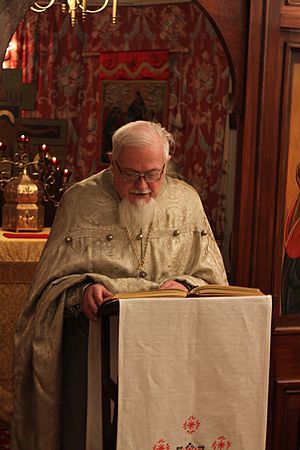Alexander Nadson facts for kids
Quick facts for kids
Fr. Alexander Nadson
|
|
|---|---|
 |
|
| Born |
Aliaksandar Bočka
8 August 1926 Haradzieja, Second Polish Republic (now Belarus)
|
| Died | 15 April 2015 (aged 88) |
| Occupation | Priest, historian |
Alexander Nadson (Belarusian: Аляксандар Надсан, Aliaksandar Nadsan, 8 August 1926 – 15 April 2015) was an important Belarusian priest, scholar, and translator. He was born on August 8, 1926, and passed away on April 15, 2015. He was known for leading Belarusian Greek-Catholic communities outside Belarus. He also played a big role in helping his people and preserving their culture.
Contents
Early Life
Fr. Nadson was born Aliaksandar Bočka in a village called Haradzieja. This village was near Niasvizh in what was then the Second Polish Republic. Today, this area is part of Belarus. His family was middle-class. His father, Anton, was a soldier in the Russian army during World War I. He also took part in the Slutsk uprising in 1920, which was against the Bolsheviks.
Nadson went to a Teacher Training College in Niasvizh. In 1944, he left Belarus. In 1945, he became a soldier in the 2nd Polish Corps. He fought in Italy and was wounded there.
Moving to Great Britain
In 1946, Fr. Nadson moved to Great Britain with the Anders' Army. He then studied at the University of London. He helped start the Association of Belarusians in Great Britain. He was also its leader from 1951 to 1953.
He worked as an editor for two newspapers, Biełarus na čužynie and Na šlachu. He also joined other Belarusian Christian groups.
Later Life
In autumn 1953, he began studying at the Greek Pontifical College in Rome. He became a priest of the Eastern Rite on November 23, 1958. Another priest, Fr. Ceslaus Sipovich, helped guide him to become a priest. Fr. Sipovich had been sent by the Vatican to start a Belarusian Catholic Mission in the UK.
In July 1959, Fr. Nadson returned to London. He continued his work with Belarusian groups there. At this time, a "Belarusian village" was growing in North Finchley, London. A building was bought to be a boarding school for sons of Belarusian immigrants. Fr. Nadson became the headmaster of this school in 1961.
The Francis Skaryna Library
From 1971, Fr. Nadson became the director of the Francis Skaryna Belarusian Library and Museum in London. This is the biggest Belarusian library outside of Belarus. Fr. Nadson helped the library grow a lot. It became known as the best collection of Belarusian books, maps, and other items in the world, outside of Belarus. Many scholars from different countries came to study there.
The library also gave Fr. Nadson many chances to do his own research. He gave talks to the Anglo-Belarusian Society. He wrote important articles for the Journal of Belarusian Studies. He wrote about people like Saint Cyril of Turau, an early Belarusian writer. He also wrote about a special book he found for the library. This book was a commentary on the Qur’an, written in Arabic by Muslim Tatars in Belarus. They spoke Belarusian every day. Fr. Nadson was also an editor for the Journal for a long time.
In 2008, he received an honorary doctorate from the European Humanities University. This showed how much his scholarly work was respected. Fr. Nadson also worked hard to translate religious texts into Belarusian.
Supporting the Church in Belarus
From 1981, he led the Belarusian Catholic mission in Great Britain. From 1986, he was the Apostolic Visitor for all Belarusian Greek-Catholic people living abroad. He strongly supported bringing back the Greek Catholic Church in Belarus. This church had been stopped in Belarus since the 1830s.
He wrote several books about the history of Belarus. He also led a charity fund for the Chernobyl disaster. This fund helped people affected by the nuclear accident in 1986.
Death
Fr. Nadson passed away at the age of 88 on April 15, 2015. He is buried in St Pancras and Islington Cemetery in East Finchley, North London.
See also
 In Spanish: Aliaksandr Nadsan para niños
In Spanish: Aliaksandr Nadsan para niños

